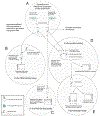In Vitro Assays for RNA Binding and Protein Priming of Hepatitis B Virus Polymerase
- PMID: 27975315
- PMCID: PMC9295686
- DOI: 10.1007/978-1-4939-6700-1_13
In Vitro Assays for RNA Binding and Protein Priming of Hepatitis B Virus Polymerase
Abstract
The hepatitis B virus (HBV) polymerase synthesizes the viral DNA genome from the pre-genomic RNA (pgRNA) template through reverse transcription. Initiation of viral DNA synthesis is accomplished via a novel protein priming mechanism, so named because the polymerase itself acts as a primer, whereby the initiating nucleotide becomes covalently linked to a tyrosine residue on the viral polymerase. Protein priming, in turn, depends on specific recognition of the packaging signal on pgRNA called epsilon. These early events in viral DNA synthesis can now be dissected in vitro as described here.The polymerase is expressed in mammalian cells and purified by immunoprecipitation. The purified protein is associated with host cell factors, is enzymatically active, and its priming activity is epsilon dependent. A minimal epsilon RNA construct from pgRNA is co-expressed with the polymerase in cells. This RNA binds to and co-immunoprecipitates with the polymerase. Modifications can be made to either the epsilon RNA or the polymerase protein by manipulating the expression plasmids. Also, the priming reaction itself can be modified to assay for the initiation or subsequent DNA synthesis during protein priming, the susceptibility of the polymerase to chemical inhibitors, and the precise identification of the DNA products upon their release from the polymerase. The identity of associated host factors can also be evaluated. This protocol closely mirrors our current understanding of the RNA binding and protein priming steps of the HBV replication cycle, and it is amenable to modification. It should therefore facilitate both basic research and drug discovery.
Keywords: Hepatitis B virus; Polymerase; Protein priming; RNA binding; Reverse transcriptase.
Figures

Similar articles
-
In vitro epsilon RNA-dependent protein priming activity of human hepatitis B virus polymerase.J Virol. 2012 May;86(9):5134-50. doi: 10.1128/JVI.07137-11. Epub 2012 Feb 29. J Virol. 2012. PMID: 22379076 Free PMC article.
-
Evidence for multiple distinct interactions between hepatitis B virus P protein and its cognate RNA encapsidation signal during initiation of reverse transcription.PLoS One. 2013 Aug 20;8(8):e72798. doi: 10.1371/journal.pone.0072798. eCollection 2013. PLoS One. 2013. PMID: 23977352 Free PMC article.
-
Mapping of Functional Subdomains in the Terminal Protein Domain of Hepatitis B Virus Polymerase.J Virol. 2017 Jan 18;91(3):e01785-16. doi: 10.1128/JVI.01785-16. Print 2017 Feb 1. J Virol. 2017. PMID: 27852858 Free PMC article.
-
[New Strategy for anti-HBV therapy: blocking P-8 interaction].Bing Du Xue Bao. 2014 Nov;30(6):713-20. Bing Du Xue Bao. 2014. PMID: 25868288 Review. Chinese.
-
Hepatitis B viruses: reverse transcription a different way.Virus Res. 2008 Jun;134(1-2):235-49. doi: 10.1016/j.virusres.2007.12.024. Epub 2008 Mar 12. Virus Res. 2008. PMID: 18339439 Review.
Cited by
-
Few basepairing-independent motifs in the apical half of the avian HBV ε RNA stem-loop determine site-specific initiation of protein-priming.Sci Rep. 2017 Aug 2;7(1):7120. doi: 10.1038/s41598-017-07657-z. Sci Rep. 2017. PMID: 28769080 Free PMC article.
-
Molecular, Evolutionary, and Structural Analysis of the Terminal Protein Domain of Hepatitis B Virus Polymerase, a Potential Drug Target.Viruses. 2020 May 22;12(5):570. doi: 10.3390/v12050570. Viruses. 2020. PMID: 32455999 Free PMC article. Review.
-
Relaxing the restricted structural dynamics in the human hepatitis B virus RNA encapsidation signal enables replication initiation in vitro.PLoS Pathog. 2022 Mar 8;18(3):e1010362. doi: 10.1371/journal.ppat.1010362. eCollection 2022 Mar. PLoS Pathog. 2022. PMID: 35259189 Free PMC article.
-
Pathogenicity and virulence of Hepatitis B virus.Virulence. 2022 Dec;13(1):258-296. doi: 10.1080/21505594.2022.2028483. Virulence. 2022. PMID: 35100095 Free PMC article. Review.
-
Establishment of a system for finding inhibitors of ε RNA binding with the HBV polymerase.Genes Cells. 2020 Aug;25(8):523-537. doi: 10.1111/gtc.12778. Epub 2020 Jun 8. Genes Cells. 2020. PMID: 32415897 Free PMC article.
References
-
- Wang GH, Seeger C (1992) The reverse transcriptase of hepatitis B virus acts as a protein primer for viral DNA synthesis. Cell 71(4):663–670 - PubMed
MeSH terms
Substances
Grants and funding
LinkOut - more resources
Full Text Sources
Other Literature Sources
Research Materials

